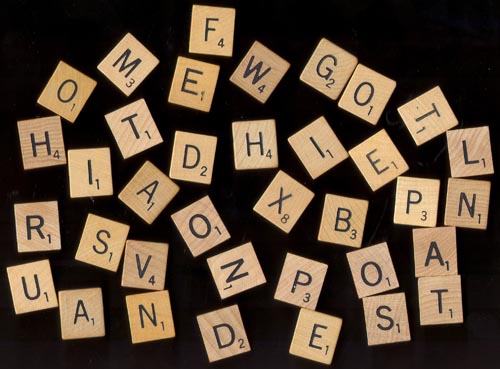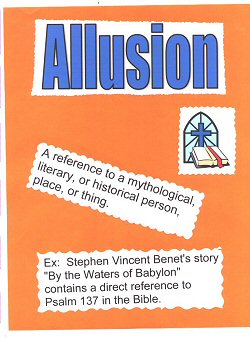
- •Table of contents:
- •Allusion
- •The Bildungsroman
- •Character Analysis Pyramid
- •Flashback
- •Is action that interrupts to show an event that happened at an earlier time which is necessary to better understanding.
- •Image is language that evokes one or all of the five senses: seeing, hearing, tasting, smelling, touching.
- •Modernism
- •Postmodern / Postmodernism
- •Symbolist / Symbolism
Isn't
it amazing how we have this group of letters -- 26 in all -- called
the alphabet and we can take those letters, arrange them in a
multitude of ways and come up with all sorts of different words.



Table of contents:
A ………………………………………………………………………………….2
B ………………………………………………………………………………….5
C ………………………………………………………………………………….6
D ………………………………………………………………………………….9
E ………………………………………………………………………………...10
F ………………………………………………………………………………...11
G ………………………………………………………………………………..14
H ………………………………………………………………………………..15
I …………………………………………………………………………………16
L ………………………………………………………………………………...19
M ………………………………………………………………………………..20
N ………………………………………………………………………………..22
P ………………………………………………………………………………...23
S …………………………………………………………………………………25
Z …………………………………………………………………………………29
B
 ibliography…………………………………………………………………...30
ibliography…………………………………………………………………...30
 Allegory
is a form of extended metaphor,
in which objects, persons, and actions in a narrative, are equated
with the meanings that lie outside the narrative itself. The
underlying meaning has moral, social, religious, or political
significance, and characters are often personifications
of abstract ideas as charity, greed, or envy. Thus an allegory is a
story with two meanings, a literal meaning and a symbolic
meaning.
Allegory
is a form of extended metaphor,
in which objects, persons, and actions in a narrative, are equated
with the meanings that lie outside the narrative itself. The
underlying meaning has moral, social, religious, or political
significance, and characters are often personifications
of abstract ideas as charity, greed, or envy. Thus an allegory is a
story with two meanings, a literal meaning and a symbolic
meaning.

Allusion
is a brief reference to a person, event, or place, real or fictitious, or to a work of art, casual reference to a famous historical or literary figure or event. An allusion may be drawn from history, geography, literature, or religion.
is a short, informal reference to a famous person or event. Allusions are to very well known characters or events, not to obscure ones. (The best sources for allusions are literature, history, Greek myth, and the Bible.) Note also that the reference serves to explain or clarify or enhance whatever subject is under discussion, without sidetracking the reader. Allusion can be wonderfully attractive in your writing because it can introduce variety and energy into an otherwise limited discussion (an exciting historical adventure rises suddenly in the middle of a discussion of chemicals or some abstract argument), and it can please the reader by reminding him of a pertinent story or figure with which he is familiar, thus helping (like analogy) to explain something difficult. The instantaneous pause and reflection on the analogy refreshes and strengthens the reader's mind.
A brief reference to a person, place, thing, event, or idea in history or literature. Allusions conjure up biblical authority, scenes from Shakespeare’s plays, historic figures, wars, great love stories, and anything else that might enrich an author’s work. Allusions imply reading and cultural experiences shared by the writer and reader, functioning as a kind of shorthand whereby the recalling of something outside the work supplies an emotional or intellectual context.
Ambiguity Literary ambiguity refers to any wording, action, or symbol that can be read in divergent ways. Intentional ambiguity in literature can be a powerful device, leaving something undetermined in order to open up multiple possible meanings.
Antithesis (from Greek antitheton, "opposition"), a figure of speech in which irreconcilable opposites or strongly contrasting ideas are placed in sharp juxtaposition and sustained tension, as in the saying "Art is long, and Time is fleeting". The opposing clauses, phrases, or sentences are roughly equal in length and balanced in contiguous grammatical structures. In poetry, the effect of antithesis is often one of tragic irony or reversal.
Antonomasia is a figure of speech in which some defining word or phrase is substituted for a person's proper name (for example, "the Bard of Avon" for William Shakespeare). In fiction, the practice of giving to a character a proper name that defines or suggests a leading quality of that character (such as Squire Allworthy, Doctor Sawbones) is also called antonomasia. The word is from the Greek antonomasia "to call by a new name."
Aposiopesis (Greek: "becoming silent"), a speaker's deliberate failure to complete a sentence. Aposiopesis usually indicates speechless rage or exasperation, as in "Why, you . . .," and sometimes implies vague threats as in, "Why, I'll . . . ." The listener is expected to complete the sentence in his mind. In ancient Greek rhetoric, the aposiopesis occasionally takes the form of a pause before a change of subject or a digression.
Asyndeton the omission of the conjunctions that ordinarily join coordinate words or clauses, as in the phrase "I came, I saw, I conquered" or in Matthew Arnold's poem The Scholar Gipsy: “Thou hast not lived, why should'st thou perish, so? Thou hadst one aim, one business, one desire; Else wert thou long since numbered with the dead!”
Atmosphere/mood The predominant emotion a reader perceives in a literary work. (i.e. Shakespeare start's his play "Othello" on a dark street of Venice at night with a heated argument between two characters. The reader feels a sense of foreboding and it establishes a sinister mood) (i.e. Shakespeare's play "Othello" takes place on a dark street in Venice, creating a sinister mood)


